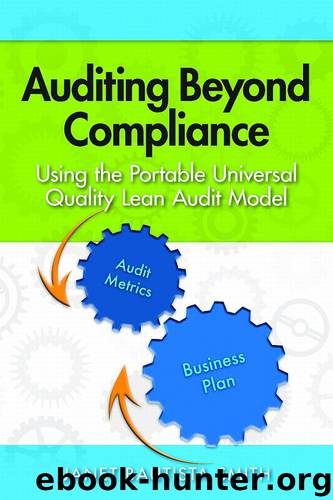Auditing Beyond Compliance: Using the Portable Universal Quality Lean Audit Model by Janet Bautista Smith

Author:Janet Bautista Smith [Smith, Janet Bautista]
Language: eng
Format: azw3
ISBN: 9780873898409
Publisher: ASQ Quality Press
Published: 2012-06-15T04:00:00+00:00
Figure 6.2 is a SIPOC diagram for a corrective action program. The trigger for this SIPOC sample analysis is the need to define a compliant and effective corrective action program to prevent failure.
Thinking backward, it’s possible to list the desired output from a corrective action program at the start of the diagram process. What are the expectations from a compliant and effective corrective action program? Once these core output elements are identified, it will be easier to uncover the relevant input critical to quality. What elements will impact the realization of the desired output aligned with the customer requirements?
Of course it’s possible to design a program outlining the milestones needed to reach the desired output without using a SIPOC diagram. SIPOC is a tool that helps visualize this path in a methodical way and helps document the evaluation blueprint.
In itemizing the elements of the SIPOC diagram, it is important to note that in some cases multiple inputs will be available. Do not let the selection process be a roadblock; choose the primary inputs (the vital few) that will likely have major impact on the desired output. How do you select the vital few? Selection may be based on many factors including risk assessment, customer requirement, and financial impact. A SIPOC diagram of the same process will change depending on the variables, which are as dynamic as the business plan and company mission. The priority level of one element may drastically shift along with changes within the company environment or outside forces such as market trends. It is therefore imperative to have appropriate triggers in place to continue the gap analysis of the system. Business is a dynamic entity. A program that is stable and compliant today may drastically change tomorrow. Subtle changes, such as a staggered customer service work schedule to cover the night shift, may impact the customer concern escalation process listed as a critical input element in the SIPOC diagram. In this example, changes in the schedule reduced the day hours available to handle the majority of incoming customer telephone calls and caused an increase in customer complaints. This situation could have been resolved or mitigated with simple real-time communication with customer. Risk assessment needs further study to determine the impact and/or resolution of this new situation resulting from a subtle change.
The lesson learned in this example is that processes and systems are continually changing over time. Even the pyramids and mighty mountains change with continuing exposure to weather, erosion, and other environmental impacts; luckily, most process and systems changes can be contained and controlled to an acceptable level. Tools such as SIPOC are important aids in this process.
Sub-processes may be further analyzed to uncover hidden information buried in SIPOC diagram process layers. To describe this “SIPOC within a SIPOC” technique, a coined expression “S-Square” will be used in this publication. It may be time consuming to break down sub-processes using the S-Square technique; discretion should be used in deciding whether this effort will yield further information that will contribute to the desired output.
Download
This site does not store any files on its server. We only index and link to content provided by other sites. Please contact the content providers to delete copyright contents if any and email us, we'll remove relevant links or contents immediately.
Weapons of Math Destruction by Cathy O'Neil(5837)
Cracking the GRE Premium Edition with 6 Practice Tests, 2015 (Graduate School Test Preparation) by Princeton Review(4049)
What It Really Takes to Get Into Ivy League and Other Highly Selective Colleges by Hughes Chuck(3554)
Fooled by Randomness: The Hidden Role of Chance in Life and in the Markets by Nassim Nicholas Taleb(2861)
The Tyranny of Metrics by Jerry Z. Muller(2850)
The Marketing Plan Handbook: Develop Big-Picture Marketing Plans for Pennies on the Dollar by Robert W. Bly(2798)
Ultralearning by Scott Young(2734)
The Official Guide for GMAT Review 2015 with Online Question Bank and Exclusive Video by Graduate Management Admission Council (GMAC)(2645)
50 Economics Classics by Tom Butler-Bowdon(2415)
The Visual MBA by Jason Barron(1983)
The Inevitable by Kevin Kelly(1835)
Data Science for Business by Foster Provost & Tom Fawcett(1815)
Out of the Crisis by Deming W. Edwards(1760)
GMAT Official Guide 2018 Verbal Review by GMAC (Graduate Management Admission Council)(1706)
Cracking the LSAT, 2012 Edition by Princeton Review(1693)
The Personal MBA: Master the Art of Business by Josh Kaufman(1650)
The Conflict Resolution Phrase Book by Barbara Mitchell & Cornelia Gamlem(1649)
Maths and Stats for Web Analytics and Conversion Optimization by Himanshu Sharma(1565)
College Essays that Made a Difference by Princeton Review(1551)
